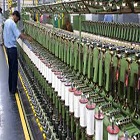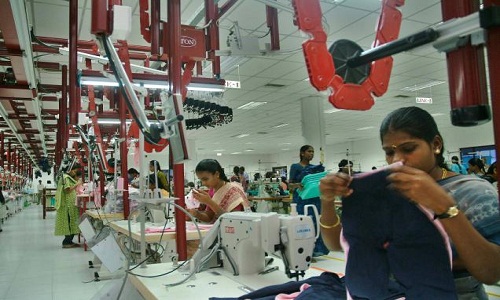"The Indian textile industry must move from being a low cost commodity exporter of fibre and yarn that has facilitated China to increase its share in global export market to 39 per cent. The country needs to be a net exporter of finished goods rather than commodity intermediaries to overcome its share of 5 per cent in the global export market. The industry needs to modernise and scale up capacities that would overcome the low manufacturing inefficiencies and be globally competitive."

The Indian textile industry must move from being a low cost commodity exporter of fibre and yarn that has facilitated China to increase its share in global export market to 39 per cent. The country needs to be a net exporter of finished goods rather than commodity intermediaries to overcome its share of 5 per cent in the global export market. The industry needs to modernise and scale up capacities that would overcome the low manufacturing inefficiencies and be globally competitive.
Maintaining competitive edge

Maintaining a competitive edge with rising costs, among other factors of production is gaining significance. C S Nopany, Chairman, Sutlej Textiles and Industries, recently pointed out there has been a sharp increase in cost of raw materials such as cotton and man-made fibres globally. Currently, cotton fibre, yarn and fabrics account for 32 per cent of India's exports, which are lower in value. Garments at 39 per cent, man-made textiles at 14 per cent, handlooms and handicrafts at 11 per cent and the rest at 4 per cent, account for the balance textile exports from India.
Government estimates, the sector needs $180-200 billion investment for achieving the desired production scale by 2024-25, which remains a formidable challenge. The essential prerequisites for getting investments on the scale required, would be to ensure ready availability of developed land for mega textile parks with adequate infrastructure, skilled manpower and easy connectivity to ports.
Investments also need to be supported by additional productive and skilled manpower; it's the only way to achieve global competitiveness and to derive the full benefit of demographic and wage advantage that India would clearly have over the next decade. So far, investment in improving skills and productivity of the workforce, by both the private sector as well as the government in alliance, is not yet at par.
Encapsulating growth
The objective should be to achieve average per man-hour, per machine output in terms of quality and quantity of levels prevailing in China over the next three to five years with the PM 's vision of Make in India with `Zero Defect, Zero Effect' at each level of the value chain. Dipali Goenka, CEO & Joint MD, Welspun India feels Make in India has been a huge success in attracting investments and augmenting manufacturing that has resulted in job creation across sectors. This has also created a huge requirement for skilled manpower. The government's initiative to impart skills to the youth, making them employable, is bound to have a multiplier effect and will propel India to the top position in the emerging global economic order.
The European Union and US account for 50 per cent of India's exports hence, there is a need to diversify to new geographies of Japan, China, Brazil and Russia. As Ashok Rajani, Chairman, Apparel Export Promotion Council point out India's ready-made garment exports during April-December of 2016 witnessed a decline of 0.2 per cent compared to the same period in the previous financial year. The market sentiments have been affected due to delays in the rollout of the special package, which was announced for the apparel sector in June 2016 and stagnation in the Europe and US markets.
Value adding enablers
To ensure export destinations are not limited to certain countries, there is a need to undertake an extensive study for a product-mix that can be tailor-made for each major market. It can be executed with a country-specific strategy conducted jointly with the ministry of textiles. From a taxation perspective, the entire value chain of textiles and apparel sector so far is under a differential tax regime that has created needless distortions. However, this will be addressed by the implementation of GST, which will likely create a level playing field for the entire value chain, with the tax slab hopefully being at the lowest rate.
The remaining challenges include certification for genuine handloom and khadi products that would facilitate in adding credibility to the respective brands in the domestic and international market. Finally, the credit availability from the banking system should be made available with longer tenures of eight years as compared to the current five year period, as the life of the machinery is over 20 years, putting considerable pressure on the business in the form of higher annual repayment cost.












